Blog
Broken Feet and Hockey

Broken feet are also known as fractured feet, and this condition can develop in an individual for many different reasons. Broken feet can occur as a result of various types of physical activities. For example, some people who play hockey may be at an increased risk of fracturing the bones in their feet. There are many reasons for this. Specifically, hockey pucks can hit players while they are on the ice. If the puck hits the foot and the foot is unprotected, this may cause bones in the feet to break or fracture. Taking a slapshot to the foot is certainly no joke, and the consequences for the feet may be severe. If you are someone that plays ice hockey and you are concerned about the possibility of fracturing your foot, it is suggested that you contact a podiatrist today for more information.
A broken foot requires immediate medical attention and treatment. If you need your feet checked, contact Dr. Tupper from Coshocton Foot Health Center. Our doctor can provide the care you need to keep you pain-free and on your feet.
Broken Foot Causes, Symptoms, and Treatment
A broken foot is caused by one of the bones in the foot typically breaking when bended, crushed, or stretched beyond its natural capabilities. Usually the location of the fracture indicates how the break occurred, whether it was through an object, fall, or any other type of injury.
Common Symptoms of Broken Feet:
- Bruising
- Pain
- Redness
- Swelling
- Blue in color
- Numbness
- Cold
- Misshapen
- Cuts
- Deformities
Those that suspect they have a broken foot shoot seek urgent medical attention where a medical professional could diagnose the severity.
Treatment for broken bones varies depending on the cause, severity and location. Some will require the use of splints, casts or crutches while others could even involve surgery to repair the broken bones. Personal care includes the use of ice and keeping the foot stabilized and elevated.
If you have any questions please feel free to contact our office located in Coshocton, OH . We offer the newest diagnostic and treatment technologies for all your foot and ankle needs.
Falling and Older People
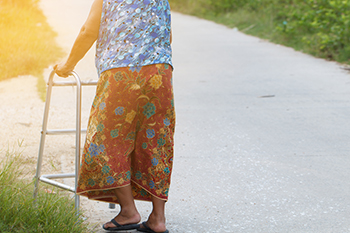
Falling can be life-threatening among the older population. A fracture may happen, and this can impact the ability to complete daily activities. It can change the quality of everyday life, possibly limiting exercising, which may affect cardiovascular health. Effective fall prevention methods can be implemented, which may help limit or prevent falling. These can include installing grab bars in the toilet and shower area, and many patients find it helpful to use a bathmat. Additionally, improving lighting in the household and removing worn rugs from the living room is beneficial. Regular physical and eye examinations can help update existing eyeglasses and medications, and adding handrails to the stairs may help prevent falling episodes. Suppose you would like additional information about how falling can affect the feet and what you can do to protect them. In that case, it is suggested that you confer with a podiatrist who can guide you toward efficient fall prevention techniques.
Preventing falls among the elderly is very important. If you are older and have fallen or fear that you are prone to falling, consult with Dr. Tupper from Coshocton Foot Health Center. Our doctor will assess your condition and provide you with quality advice and care.
Every 11 seconds, an elderly American is being treated in an emergency room for a fall related injury. Falls are the leading cause of head and hip injuries for those 65 and older. Due to decreases in strength, balance, senses, and lack of awareness, elderly persons are very susceptible to falling. Thankfully, there are a number of things older persons can do to prevent falls.
How to Prevent Falls
Some effective methods that older persons can do to prevent falls include:
- Enrolling in strength and balance exercise program to increase balance and strength
- Periodically having your sight and hearing checked
- Discuss any medications you have with a doctor to see if it increases the risk of falling
- Clearing the house of falling hazards and installing devices like grab bars and railings
- Utilizing a walker or cane
- Wearing shoes that provide good support and cushioning
- Talking to family members about falling and increasing awareness
Falling can be a traumatic and embarrassing experience for elderly persons; this can make them less willing to leave the house, and less willing to talk to someone about their fears of falling. Doing such things, however, will increase the likelihood of tripping or losing one’s balance. Knowing the causes of falling and how to prevent them is the best way to mitigate the risk of serious injury.
If you have any questions, please feel free to contact our office located in Coshocton, OH . We offer the newest diagnostic and treatment technologies for all your foot care needs.
Arthritis Can Cause Pain in the Feet and Ankles
Examples of Achilles Tendon Injuries

The Achilles tendon connects the calf muscles to the heel. It is located in the lower part of the calf, and it is responsible for walking, running, and standing on tiptoes. If this tendon becomes injured, it can cause severe pain and discomfort. An injury can happen from increasing speed and distance too quickly, a common injury among runners. The tendon can become partially or completely torn, and there are similar symptoms that can accompany either type. These symptoms can include hearing a popping sound at the time of the injury, and the heel may be swollen, painful, or stiff. There are two types of Achilles tendonitis, and they are classified as non insertional and insertional. The former may be more prevalent among younger people, and it affects the fibers in the middle of the tendon. The latter involves the fibers in the lower part of the tendon, and both can result from overuse. Partial tears may gradually heal on their own, with adequate rest and keeping as much weight off of the foot as possible. If the tendon is completely torn, it is suggested that a podiatrist who can effectively treat an Achilles tendon injury be contacted as quickly as possible .
Achilles tendon injuries need immediate attention to avoid future complications. If you have any concerns, contact Dr. Tupper of Coshocton Foot Health Center. Our doctor can provide the care you need to keep you pain-free and on your feet.
What Is the Achilles Tendon?
The Achilles tendon is a tendon that connects the lower leg muscles and calf to the heel of the foot. It is the strongest tendon in the human body and is essential for making movement possible. Because this tendon is such an integral part of the body, any injuries to it can create immense difficulties and should immediately be presented to a doctor.
What Are the Symptoms of an Achilles Tendon Injury?
There are various types of injuries that can affect the Achilles tendon. The two most common injuries are Achilles tendinitis and ruptures of the tendon.
Achilles Tendinitis Symptoms
- Inflammation
- Dull to severe pain
- Increased blood flow to the tendon
- Thickening of the tendon
Rupture Symptoms
- Extreme pain and swelling in the foot
- Total immobility
Treatment and Prevention
Achilles tendon injuries are diagnosed by a thorough physical evaluation, which can include an MRI. Treatment involves rest, physical therapy, and in some cases, surgery. However, various preventative measures can be taken to avoid these injuries, such as:
- Thorough stretching of the tendon before and after exercise
- Strengthening exercises like calf raises, squats, leg curls, leg extensions, leg raises, lunges, and leg presses
If you have any questions please feel free to contact our office located in Coshocton, OH . We offer the newest diagnostic tools and technology to treat your foot and ankle needs.
Ankle Pain and Avulsion Fractures
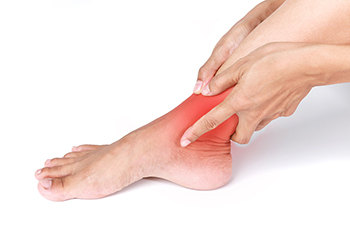
The ankle is an essential part of the human foot because it can act as a shock absorber and help facilitate motion. However, the ankle can also be subject to a significant amount of pain, which can cause discomfort to patients. One reason why the ankle might be subject to pain is due to something called an avulsion fracture. An avulsion fracture is a condition that can occur when, at the ligamentous or tendinous attachment, a piece of a bone is drawn away. Avulsion fractures at the ankle can be caused by a traumatic traction, when the tendon can bear more load than the bone. If you are someone that has recently endured an avulsion fracture, it is suggested that you schedule an appointment with a podiatrist immediately.
Ankle pain can be caused by a number of problems and may be potentially serious. If you have ankle pain, consult with Dr. Tupper from Coshocton Foot Health Center. Our doctor will assess your condition and provide you with quality foot and ankle treatment.
Ankle pain is any condition that causes pain in the ankle. Due to the fact that the ankle consists of tendons, muscles, bones, and ligaments, ankle pain can come from a number of different conditions.
Causes
The most common causes of ankle pain include:
- Types of arthritis (rheumatoid, osteoarthritis, and gout)
- Ankle sprains
- Broken ankles
- Achilles tendinitis
- Achilles tendon rupture
- Stress fractures
- Bursitis
- Tarsal tunnel syndrome
- Plantar fasciitis
Symptoms
Symptoms of ankle injury vary based upon the condition. Pain may include general pain and discomfort, swelling, aching, redness, bruising, burning or stabbing sensations, and/or loss of sensation.
Diagnosis
Due to the wide variety of potential causes of ankle pain, podiatrists will utilize a number of different methods to properly diagnose ankle pain. This can include asking for personal and family medical histories and of any recent injuries. Further diagnosis may include sensation tests, a physical examination, and potentially x-rays or other imaging tests.
Treatment
Just as the range of causes varies widely, so do treatments. Some more common treatments are rest, ice packs, keeping pressure off the foot, orthotics and braces, medication for inflammation and pain, and surgery.
If you have any questions, please feel free to contact our office located in Coshocton, OH . We offer the newest diagnostic and treatment technologies for all your foot care needs.
Heel Pain and Cancer
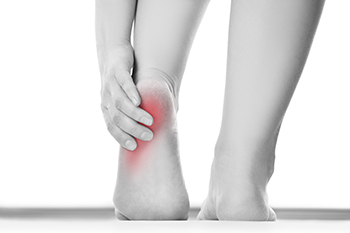
Heel pain can be an annoyance for a variety of patients for many different reasons. For example, heel pain may be linked to a condition known as plantar fasciitis. Alternatively, heel pain could be caused by an individual’s obesity and the extent to which their excess weight is putting added pressure on the feet. However, heel pain might also be a side effect of certain cancer treatments. Sometimes, when an individual with cancer receives treatment, heel pain can result. The reason for this is that some treatments lead to a loss of bone density and even muscle wasting. As a result, conditions such as plantar fasciitis can become more likely and ultimately cause heel pain. If you are someone that is receiving cancer treatment and you have heel pain, it is suggested that you contact a podiatrist today.
Many people suffer from bouts of heel pain. For more information, contact Dr. Tupper of Coshocton Foot Health Center. Our doctor can provide the care you need to keep you pain-free and on your feet.
Causes of Heel Pain
Heel pain is often associated with plantar fasciitis. The plantar fascia is a band of tissues that extends along the bottom of the foot. A rip or tear in this ligament can cause inflammation of the tissue.
Achilles tendonitis is another cause of heel pain. Inflammation of the Achilles tendon will cause pain from fractures and muscle tearing. Lack of flexibility is also another symptom.
Heel spurs are another cause of pain. When the tissues of the plantar fascia undergo a great deal of stress, it can lead to ligament separation from the heel bone, causing heel spurs.
Why Might Heel Pain Occur?
- Wearing ill-fitting shoes
- Wearing non-supportive shoes
- Weight change
- Excessive running
Treatments
Heel pain should be treated as soon as possible for immediate results. Keeping your feet in a stress-free environment will help. If you suffer from Achilles tendonitis or plantar fasciitis, applying ice will reduce the swelling. Stretching before an exercise like running will help the muscles. Using all these tips will help make heel pain a condition of the past.
If you have any questions please contact our office located in Coshocton, OH . We offer the newest diagnostic and treatment technologies for all your foot and ankle needs.
Running on Uneven Surfaces

Runners, both professional and recreational, need to take particular care of the health of their feet. If a runner is not taking certain measures, they might be putting themselves at risk of developing a foot injury or condition from running. One of the measures that runners may consider taking is running on even surfaces. When an individual chooses to run on uneven surfaces, the unbalanced surface can create an off-center force in the runner’s feet. As a result, a runner may be more likely to develop certain foot conditions such as tendonitis, joint inflammation or a fracture of the foot. If you are someone that frequently engages in running or similar physical activities, it is strongly suggested that you are under the care of a podiatrist. This foot specialist will be able to treat your foot conditions, and answer any questions you may have about running on uneven surfaces.
All runners should take extra precaution when trying to avoid injury. If you have any concerns about your feet, contact Dr. Tupper of Coshocton Foot Health Center. Our doctor will treat your foot and ankle needs.
How to Prevent Running Injuries
There are a lot of mistakes a runner can make prior to a workout that can induce injury. A lot of athletes tend to overstretch before running, instead of saving those workouts for a post-run routine. Deep lunges and hand-to-toe hamstring pulls should be performed after a workout instead of during a warmup. Another common mistake is jumping into an intense routine before your body is physically prepared for it. You should try to ease your way into long-distance running instead of forcing yourself to rush into it.
More Tips for Preventing Injury
- Incorporate Strength Training into Workouts - This will help improve the body’s overall athleticism
- Improve and Maintain Your Flexibility – Stretching everyday will help improve overall performance
- “Warm Up” Before Running and “Cool Down” Afterward – A warm up of 5-10 minutes helps get rid of lactic acid in the muscles and prevents delayed muscle soreness
- Cross-Training is Crucial
- Wear Proper Running Shoes
- Have a Formal Gait Analysis – Poor biomechanics can easily cause injury
If you have any questions, please feel free to contact our office located in Coshocton, OH . We offer the newest diagnostic and treatment technologies for all your foot care needs.
Gout Pain Can Be Managed
My Foot Hurts
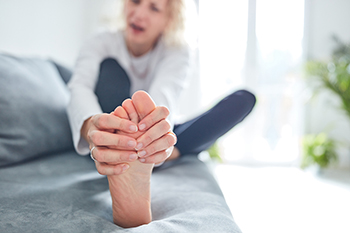
Foot pain is often ignored until it impacts everyday routines. Having chronic foot pain may cause unstable foot function, which can increase the chances of falling. Common reasons for foot pain can include obesity and wearing shoes that do not fit correctly for extended periods. A stress fracture can be a likely cause of foot pain and can cause difficulty in walking. Heel pain can come from plantar fasciitis, a heel spur, or an Achilles tendon injury. General foot pain may be indicative of psoriatic arthritis and can affect the toenails, heels, and soles of the feet. Additionally, gout is a form of arthritis that often targets the joints in the big toe. Gout occurs due to excess uric acid levels in the blood which may come from specific types of foods that are eaten. If you have foot pain for any reason, it is strongly suggested that you consult with a podiatrist who can properly diagnose and treat various types of foot pain.
Foot Pain
Foot pain can be extremely painful and debilitating. If you have a foot pain, consult with Dr. Tupper from Coshocton Foot Health Center. Our doctor will assess your condition and provide you with quality foot and ankle treatment.
Causes
Foot pain is a very broad condition that could be caused by one or more ailments. The most common include:
- Bunions
- Hammertoes
- Plantar Fasciitis
- Bone Spurs
- Corns
- Tarsal Tunnel Syndrome
- Ingrown Toenails
- Arthritis (such as Gout, Rheumatoid, and Osteoarthritis)
- Flat Feet
- Injury (from stress fractures, broken toe, foot, ankle, Achilles tendon ruptures, and sprains)
- And more
Diagnosis
To figure out the cause of foot pain, podiatrists utilize several different methods. This can range from simple visual inspections and sensation tests to X-rays and MRI scans. Prior medical history, family medical history, and any recent physical traumatic events will all be taken into consideration for a proper diagnosis.
Treatment
Treatment depends upon the cause of the foot pain. Whether it is resting, staying off the foot, or having surgery; podiatrists have a number of treatment options available for foot pain.
If you have any questions, please feel free to contact our office located in Coshocton, OH . We offer the newest diagnostic and treatment technologies for all your foot care needs.
Relief Methods for Sever’s Disease

Heel pain is a common symptom with Sever’s disease. It is a condition that affects children and young teenagers who engage in running and jumping activities, and it can be quite painful. Additionally, wearing shoes with studs may increase the chances of developing Sever’s disease. A growth spurt can cause the bones to grow faster than the surrounding muscles and tendons, and the Achilles tendon is often affected. This tendon connects the heel to the calf muscles and can become sore with existing heel pain. This condition can be properly diagnosed when symptoms and performance levels are noticed, and treatment can begin with temporarily stopping the activity that caused the pain. This is typically followed by performing stretches that can strengthen the affected heel. Mild relief may be found when cushioned heel pads are worn and the leg is frequently elevated, possibly helping to reduce existing swelling. Limping and standing on tip toes may indicate your active child has Sever’s disease, and if applicable, it is suggested that you consult with a podiatrist who can offer relief and treatment techniques.
Sever's disease often occurs in children and teens. If your child is experiencing foot or ankle pain, see Dr. Tupper from Coshocton Foot Health Center. Our doctor can treat your child’s foot and ankle needs.
Sever’s Disease
Sever’s disease is also known as calcaneal apophysitis, which is a medical condition that causes heel pain I none or both feet. The disease is known to affect children between the ages of 8 and 14.
Sever’s disease occurs when part of the child’s heel known as the growth plate (calcaneal epiphysis) is attached to the Achilles tendon. This area can suffer injury when the muscles and tendons of the growing foot do not keep pace with bone growth. Therefore, the constant pain which one experiences at the back of the heel will make the child unable to put any weight on the heel. The child is then forced to walk on their toes.
Symptoms
Acute pain – Pain associated with Sever’s disease is usually felt in the heel when the child engages in physical activity such as walking, jumping and or running.
Highly active – Children who are very active are among the most susceptible in experiencing Sever’s disease, because of the stress and tension placed on their feet.
If you have any questions, please feel free to contact our office located in Coshocton, OH . We offer the newest diagnostic and treatment technologies for all your foot and ankle injuries.
More...
Older People and Achilles Tendonitis

Tendonitis is common among people who incur an Achilles tendon injury. Heel and calf pain often accompany this ailment, and it can be uncomfortable. The Achilles tendon connects the calf muscle to the heel and may become torn from an injury. These can include overuse injuries from running on hard surfaces or increasing speed and distance too quickly while running. People who have arthritis may be prone to Achilles tendonitis, and it can affect older and middle-aged patients more than younger adults. Common symptoms are immediate heel pain and difficulty pointing and flexing the foot. Additionally, the area may be warm and tender to the touch. A proper diagnosis is needed to rule out the possibility of a fracture. If you have endured an Achilles tendon injury, it is suggested that a podiatrist be consulted who can effectively help you manage this condition.
Achilles tendon injuries need immediate attention to avoid future complications. If you have any concerns, contact Dr. Tupper of Coshocton Foot Health Center. Our doctor can provide the care you need to keep you pain-free and on your feet.
What Is the Achilles Tendon?
The Achilles tendon is a tendon that connects the lower leg muscles and calf to the heel of the foot. It is the strongest tendon in the human body and is essential for making movement possible. Because this tendon is such an integral part of the body, any injuries to it can create immense difficulties and should immediately be presented to a doctor.
What Are the Symptoms of an Achilles Tendon Injury?
There are various types of injuries that can affect the Achilles tendon. The two most common injuries are Achilles tendinitis and ruptures of the tendon.
Achilles Tendinitis Symptoms
- Inflammation
- Dull to severe pain
- Increased blood flow to the tendon
- Thickening of the tendon
Rupture Symptoms
- Extreme pain and swelling in the foot
- Total immobility
Treatment and Prevention
Achilles tendon injuries are diagnosed by a thorough physical evaluation, which can include an MRI. Treatment involves rest, physical therapy, and in some cases, surgery. However, various preventative measures can be taken to avoid these injuries, such as:
- Thorough stretching of the tendon before and after exercise
- Strengthening exercises like calf raises, squats, leg curls, leg extensions, leg raises, lunges, and leg presses
If you have any questions please feel free to contact our office located in Coshocton, OH . We offer the newest diagnostic tools and technology to treat your foot and ankle needs.
Shockwave Therapy for Plantar Fasciitis
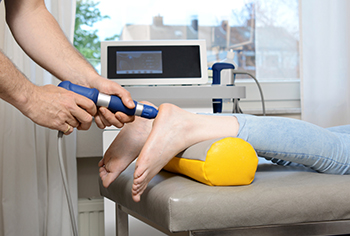
Many people seek help for pain from plantar fasciitis, an inflammation of the band of tissue that runs beneath the foot from the toes to the heel. Some simple remedies for plantar fasciitis include rest, exercise, and medication. It has also been found that shockwave therapy can be effective in reducing pain and helping to heal the plantar fascia. This non-invasive treatment consists of applying penetrating waves of ultrasound energy into the inflamed area. The body responds by creating new blood vessels and stimulates nerve endings that can help to heal the area. While the treatment occurs without any surgery, it can be painful. Sometimes multiple treatments are required, depending on the severity of the plantar fasciitis. Results of shockwave therapy may vary, but most commonly the pain of plantar fasciitis subsides. Fortunately, there are many ways to treat symptoms of plantar fasciitis. Please consult a podiatrist for more information on the treatment options that are best for you.
Shockwave therapy is a treatment commonly used to treat various injuries and conditions, particularly plantar fasciitis in the feet. To learn more, consult with Dr. Tupper from Coshocton Foot Health Center. Our doctor can provide the care you need to keep you pain-free and on your feet.
Shockwave Therapy
Shockwave therapy is a new treatment option designed to treat bone conditions such as tennis elbow, shoulder pain, and others. Shockwave therapy uses high intensity sound waves that are directed to the affected tissues of the body with pinpoint accuracy. The effects are very beneficial, leading to a production of collagen fibers, eliminating inflammation.
Who Benefits from Shockwave?
Shockwave is recommended for patients suffering from heel pain and associated problems. Heel pain is a common condition which can be caused by obesity, overexertion, and spending a substantial amount of time on hard floors with your feet exposed and unsupported.
Fast and Easy
The therapy is actually a simple process that can leave patients feeling better the very next day. Shockwave therapy is not as dramatic as it sounds. It enables more blood flow to effected areas, addressing the source of the problem and allowing treatment to last for a long time.
Treatment & Recovery Time
Shockwave treatment will enable your feet to recover quickly. This is especially important since surgery is not required. It is cost effective and does not require the use of anesthesia. This treatment is a better option to surgery, since it is proven safe.
If you have any questions, please feel free to contact our office located in Coshocton, OH . We offer the newest diagnostic and treatment technologies for all your foot and ankle needs.
Possible Relief Methods for Plantar Fasciitis

Many athletes suffer from a foot condition that is known as plantar fasciitis. It is a common ailment that comes from the repetitive force while participating in running and jumping activities. It may also affect people who wear shoes that do not fit correctly, or who have an abnormal foot structure. Additionally, it may happen to people who stand on hard surfaces for most of the day, or increase speed and distance too quickly while running. Plantar fasciitis happens as a result of an inflammation of the plantar fascia, which is the band of tissue that is found on the sole of the foot. It connects the heel to the toes, and an injury or a tear to the plantar fascia may result in the development of this condition. Heel pain is a common symptom of plantar fasciitis, and it may be worse in the morning after arising. Relief may be found when weight is kept off of the affected foot, and is frequently elevated while resting. Some patients have found success when specific stretches are done, and this may help to accelerate healing. If you have heel pain, it is strongly advised that you are under the care of a podiatrist who can properly diagnose and treat plantar fasciitis.
Plantar fasciitis can be very painful and inconvenient. If you are experiencing heel pain or symptoms of plantar fasciitis, contact Dr. Tupper from Coshocton Foot Health Center. Our doctor can provide the care you need to keep you pain-free and on your feet.
What Is Plantar Fasciitis?
Plantar fasciitis is the inflammation of the thick band of tissue that runs along the bottom of your foot, known as the plantar fascia, and causes mild to severe heel pain.
What Causes Plantar Fasciitis?
- Excessive running
- Non-supportive shoes
- Overpronation
- Repeated stretching and tearing of the plantar fascia
How Can It Be Treated?
- Conservative measures – anti-inflammatories, ice packs, stretching exercises, physical therapy, orthotic devices
- Shockwave therapy – sound waves are sent to the affected area to facilitate healing and are usually used for chronic cases of plantar fasciitis
- Surgery – usually only used as a last resort when all else fails. The plantar fascia can be surgically detached from the heel
While very treatable, plantar fasciitis is definitely not something that should be ignored. Especially in severe cases, speaking to your doctor right away is highly recommended to avoid complications and severe heel pain. Your podiatrist can work with you to provide the appropriate treatment options tailored to your condition.
If you have any questions please feel free to contact our office located in Coshocton, OH . We offer the newest diagnostic and treatment technologies for all your foot and ankle needs.




